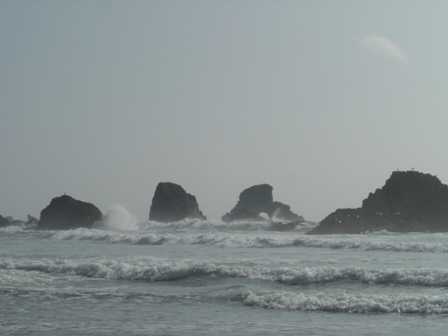Short trails starting at the upper parking area give you views of the ocean, the beaches, and the rocky sea stacks that jut up from below the surface.
In the photo above, look at the upper right side: that’s Haystack Rock, an Oregon Coast landmark you’ll find on postcards for sale throughout the state. You can get a better view of Haystack Rock from Cannon Beach, near the town’s center.

The trail gives you a great view of Sea Lion Rocks, which are home to many different kinds of sea birds, and depending on the time of year, sea lions.

Looking north, you can see Indian Beach, our next stop.

Ecola State Park also allows you a great view of one of the Pacific Coast’s most remote and foreboding lighthouses. The Tillamook Head Light is offshore, perched atop a tiny rock. Even though its light is 133 feet above sea level, the crashing waves from several storms over the past 120 plus years have smashed the glass windows surrounding the light, and hurled rocks through the roof of the light keepers’ quarters.

After observing Ecola’s Indian Beach from above, drive down to the lower parking area, kick off your shoes, and go wading in the surf. Indian Beach is almost as impressive as Washington’s Ruby Beach, to the north (although it’s likely this beach will be a lot more crowded).

Tall rocks rise from the ocean along the beach, and they take a serious beating from the pounding waves.

There’s also some driftwood lining the shore, but not nearly as much as you’ll find at beaches further north.
After saying goodbye to the ocean, head back up US 101 to US 26, and drive toward Portland.
Note: This trip was first published in 2004.







No comments